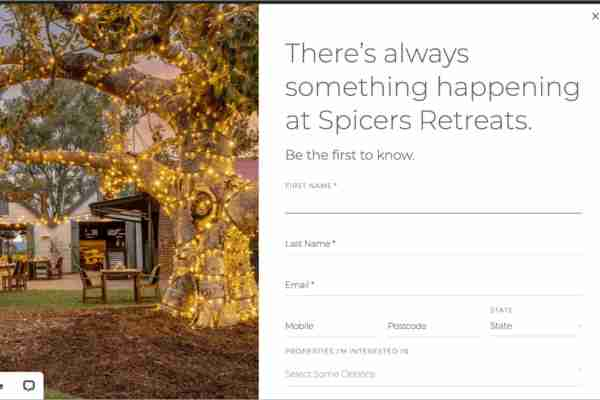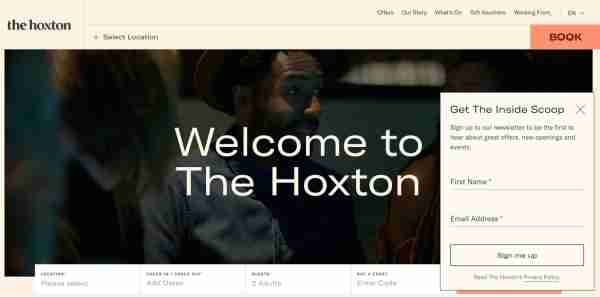The 7 top hotel marketing channels and how to make the most of them
The 7 top hotel marketing channels and how to make the most of them
The global online travel market is estimated to be worth an impressive $1 billion in 2030. The demand is there, but are you capturing your share of it? To get your piece of the pie, you need to cover multiple hotel marketing channels and optimize them for direct booking revenue.
Hotel marketing channels are the avenues where you interact with your guests (and potential guests). From research to booking to post-stay surveys, there are dozens of touchpoints throughout the guest journey that you need to engage with and track as a hotel marketer.
Understanding how these channels are transforming will help you keep abreast of the guest experience and drive direct booking revenue. Let’s walk through the six top hotel marketing channels and how you can capitalize on them.
What you will see here:
1. Official website
Your website is your digital home–and just as much a representation of your brand as the front lobby. Your website should be informative, easy to navigate, and optimized for mobile. A poor website experience could influence guests to book on OTAs or overlook your hotel entirely, costing you direct revenue.
How to capitalize on your website
- Provide a seamless direct booking experience. Make the reservation CTA clear, and ensure your guests can easily add their search criteria before receiving the room rates.
- Showcase high quality images of your property and services. Show off your property. Include photos of the rooms, restaurants, and other areas that can be unique selling points. Invite guests to share their own photos that you can also display on your website.
- Market your location. Do you have a historic restaurant next door? Or a flea market nearby? Let your guests know what else they can enjoy around your property!
- Optimize your website for mobile. More travelers are booking their trips on their phones. In fact, about 2/3 Milennials are comfortable with planning their entire trip on mobile. Mobile friendly websites also rank better on Google, which leads to higher traffic to your site.
The Hoxton, a modern and vibrant urban group, and Spicers Retreats a luxury getaway group, are two great examples of brands with excellent websites.

Email sign up form on Spicers Retreats’ website

Email sign up form on The Hoxton’s website
Both brands welcome guests with stunning visuals. Guests can easily find the navigation at the top of the page, browse high-quality photos of the properties and other services, and book seamlessly.
The cherry on top—both brands are actively capturing first-party data for marketing purposes. Spicers Retreats and The Hoxton have pop-ups on their home pages where people can share their emails in exchange for updates and special offers. That email address can then be associated with all of the bookings and campaign interactions the customer makes.
2. Email Marketing
If you think email marketing is dead, we’re here to tell you that it’s more alive than ever. Email marketing is the
number 1 preferred communication channel by millennials and almost all generations. This is because email is less invasive, and searchable. When done right, with every $1 dollar spend, marketers can receive $36 in return.
How to capitalize on email marketing
- Automate your email campaigns. The best thing about email marketing is that you can automate the sending process. Create “set it and forget it” campaigns such as pre-arrival, winback, and shopping cart abandonment series that trigger automatically based on guest activity.
- Send highly segmented and personalized messaging. Segmented emails often see 2.5x higher open rates and 3x higher click-through rates. Your guests want offers that are relevant to them. Combining data such as your guests’ booking history, survey responses, and marketing engagement (all available in a rich guest profile or in your CDP) allows you to create specific segments for highly effective email campaigns.
- Create engaging newsletters. Keep your property at the top of guests’ minds by sending a regular newsletter with special room offers, notable announcements, or nearby events you want to highlight.
- Invite guests to leave reviews. Your guests may notice things that you don’t. Asking for their honest feedback can be valuable for necessary improvements, and to give credit to your staff when guests take the time to express their satisfaction.
- Experiment with your messages, and see what performs well and what doesn’t over time. For example, try A/B Testing your email subject lines, or get creative with your offer. Remember, your guests’ behavior can always change—continuously experimenting will keep you on top of shifting trends.
Need some inspiration for your next emails? We have two newsletter examples from The Other House, a hotel group based in the UK, and the InterContinental Maldives Maamunagau Resort, an IHG hotel based in the Maldives. Both newsletters highlighted the experiences and events taking place at the properties in that month. The Other House successfully generated 425 room nights from their April newsletter, and the InterContinental Maldives Maamunagau Resort ’s January newsletter led to 139 room nights.
For more successful email campaign examples with results, check out our Inspirations page. And if you want to learn more about email marketing, take a look at our basics of email marketing guide.
3. Text messaging
We all know what it’s like to be glued to our phones, day in and day out. With SMS open rate as high as 98%, it’s a coveted channel for marketers. Text messaging allows you to send your guests simplified updates and promotions.
How to capitalize on text messaging
- Automate your text campaigns. Just like email marketing, you can automate your marketing process throughout the guest journey. You can also create a clear and concise script that your AI can use to answer frequently asked questions.
- Send highly segmented and personalized messaging. With text messaging, you can send simplified segmented and personalized messaging. This can act as a simple reminder of your guest’s booked services, or a promotional offer followed by the code to redeem the service.
- Invite guests to leave reviews. Text messaging is another tool that you can utilize for guest feedback.
With text-messaging, you can give your guests a point of contact at any time throughout their stay. Vintage Hotels, a group of luxury hotels in Canada, elevated their guests’ communications with text messages. In the middle of staff shortages and rising travel demand, the property was still able to stay in touch and make their guests feel heard with text messages. You can learn more about how AI can help you improve your guest communications in our blog post.
4. Online reviews
A study by TripAdvisor found that 81% of travelers read reviews during their booking decision process. On top of qualitative feedback, reviews on TripAdvisor, Google and Booking.com provide quantitative data that you can monitor and track over time, and use to make strategic improvements.
How to capitalize on online reviews
- Proactively gather reviews. There are multiple touchpoints where you can encourage guests to leave reviews, including during the check-out process, in your post-stay emails, or even through interactions with your staff. You can also reward your guests with special offers for completing a review, such as a drink in the house that they can redeem with a code once the review is submitted.
- Respond to both negative and positive reviews. 4 out of 5 travelers believe believe that hotels who respond to reviews care about their guests. Hoteliers are often more responsive towards the negative reviews, but responding to positive reviews is just important. Dedicate time in your week to answer reviews. Be kind and genuine in your responses, and don’t forget to forward compliments to your team!
Learn more about how to respond to negative reviews here and positive reviews here. We also have an online Guest Feedback Certification course led by Revinate Customer Success Managers.
5. Paid search and metasearch
Paid search, or Search Engine Advertising, can help you increase visibility and conversion when travelers are researching your hotel or destination online. You can bid against branded keywords, which include your property name (e.g. “The Landmark London”) to make sure your hotel website is positioned above OTAs, or generic keywords associated with travel destinations or accommodation types, such as “hotel in Sydney” or “luxury Maldives resort.” Using paid search advertisements against relevant keywords can boost your visibility and capture demand.
In addition to paid research, there’s also Metasearch. Metasearch is a tool that allows travelers to compare rates across different travel platforms such as Booking.com, your official website, Trip.com, hotels.com and more, in order to find the best rates for the travelers at their chosen destination and dates. Just as with paid search ads, you can sponsor results on metasearch sites to stand out from the competition.

Metasearch example on Google
Both channels can boost visibility and engagement, and reduce dependencies on OTAs as you are competing with them for possibly the same keywords. Many marketers opt for paid search to enhance organic search engagement, and use metasearch to create an easier and faster booking decision process for travelers.
How to capitalize on paid search and metasearch
- Focus on keywords. The more specific the keyword, the better the ROI–especially when it comes to generic search terms like “hotels in Bangkok.” Keywords like “best 5 star hotels Bangkok” or “best rooftop view Bangkok” can get you more bang for your buck. Use tools like Semrush or Google Keyword Planner to optimize your campaigns.
- Show all room rates. Instead of just displaying your cheapest rates, build trust with potential guests by showing your full range of room rates. If you include every option available, people are less likely to turn to other booking platforms to explore rates. You also increase upsell opportunities.
- Measure results and benchmark your performance. As the adage goes, “what gets measured, gets managed.” Keep track of KPIs like click-through rate, impression share, cost-per click, and conversion rate to ensure your advertising dollars are well spent.
6. Online Travel Agencies (OTAs)
Online Travel Agencies like Booking.com, Agoda, and others allow guests to search for hotel rooms, transportation, and travel packages from hundreds of businesses at the same time. Travelers have the flexibility to browse hotels based on requirements such as parking or breakfasts included. They can also browse with a range of dates if they don’t have strict travel plans.
Though OTAs are an important distribution channel that contribute to your bookings, you have to pay a relatively high percentage of the total booking cost (usually 15-30%) for their services. There may also be hidden fees. Therefore it’s important to be strategic in your engagements with OTAs and make sure you don’t diminish your opportunities for direct bookings.
How to capitalize on OTAs
- Stand out from your competitors. Use high quality images that entice guests, provide clear basic information, and use attention-grabbing keywords.
- Manage guest reviews. Some OTAs also host traveler reviews, such as Booking.com. Make sure that you check reviews regularly and respond to them.
- Measure and review results. You can always change up your engagements with OTAs. Take the time to continuously reassess your investment. Sunish Sadasivan, VP of Revenue Management and E-commerce for Chroma Hospitality, conducted an experiment where he shut down their OTAs for 30 days, And surprisingly, doing so gave their website the main spotlight that it deserved. After an initial dip, they recovered most of their bookings at higher margins through direct channels.
7. Social media
Social channels are not just for younger audiences. While some platforms are more popular with certain generations—like TikTok for GenZ or Facebook for Boomers—there are plenty of overlapping audiences. Choose several platforms to make sure you are reaching your target demographics.
What’s more, 97% of guests share their travel pictures on social media. These posts, in turn, inspire other travelers to follow suit. Creating your own original content, working with influencers, and re-sharing guest content are all ways to keep your social presence active.
How to capitalize on social media
- Complete your profile. A complete profile gives you credibility and makes it easier for guests to find you. Include a link to your website so that travelers can book directly.
- Create a social content calendar. The purpose of a content calendar is to keep track of all social media posts in an organized manner. You can create one manually using Excel or Google Sheets, or use a planner such as Hootsuite, Semrush and Later.
- Run ads. The targeting capabilities of social media ads can be complimentary to your organic posts. You can target an audience based on location, demographic, content they consume, and more. Facebook, Instagram, Youtube, TikTok and LinkedIn all have advertising opportunities. You can also use your existing guest data to find look-alike audiences and advertise to potential new guests that share interests or characteristics with your loyal customers.
- Interact with your guests. Here’s your chance to be creative. Run promotions, polls, or contests that are specific to your social channels. Comment on posts taken at your property and repost guest content.
Use first-party data to optimize your top hotel marketing channels
The foundation of effective marketing campaigns is good data. More often than not, hoteliers’ customer data is siloed in different tools, making it difficult to understand guest behavior and engagement across channels. With a Customer Data Platform (CDP), you can get all of your guest data in one place and use it to get a complete picture of your customers. Use this data to create highly segmented audiences, find the most effective channels, and increase your marketing ROI.
Do you want to learn more about how you can turn data into revenue? Book a meeting with us today.
Related Posts
This site is protected by reCAPTCHA and the Google Privacy Policy and Terms of Service apply. View our Terms & Conditions here. *Required fields.



